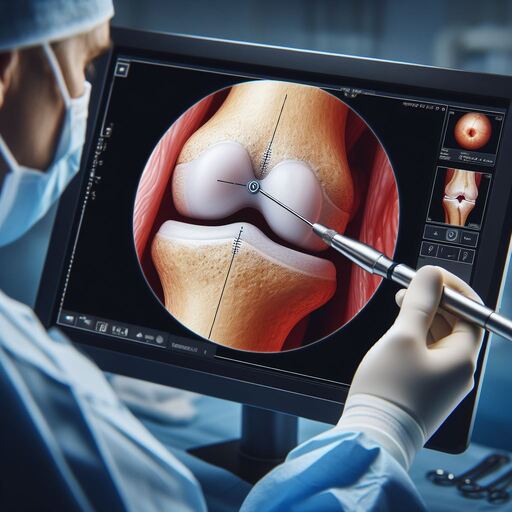The Speedy Benefits of Arthroscopy
The Speedy Benefits of Arthroscopy
Fast Track to Recovery: The Speedy Benefits of Arthroscopy
In the world of orthopedic surgery, arthroscopy stands out as a beacon of innovation and efficiency. This minimally invasive technique allows surgeons to explore, diagnose, and treat joint problems with precision, resulting in less pain, minimal scarring, and notably quicker recovery times compared to traditional open surgery. This article dives into the benefits of arthroscopy, illustrating why it is often the preferred choice for patients and surgeons alike when addressing common joint issues.
What is Arthroscopy?
Arthroscopy involves the use of a specialized instrument known as an arthroscope, a small fiber-optic camera that allows surgeons to view the interior of a joint through a small incision. The camera projects images onto a screen, providing a clear and magnified view of the joint’s structure. This method is most commonly employed for diagnosing and repairing problems in the knee, shoulder, elbow, ankle, hip, and wrist.
The Advantages of Arthroscopy
1. Reduced Trauma to the Body: Arthroscopy’s minimal invasiveness is one of its primary advantages. Traditional open surgery often requires large incisions that cut through skin and muscle, leading to significant trauma and longer recovery periods. In contrast, arthroscopy uses small incisions — usually the size of a keyhole — which means less damage to the surrounding tissues and reduced overall trauma.
The Speedy Benefits of Arthroscopy
2. Decreased Risk of Infection: With smaller incisions comes a lower risk of postoperative infections. The exposure of internal tissues to potential external contaminants is minimized, which significantly reduces the likelihood of infections and complications that can arise from them.
3. Less Postoperative Pain: Patients typically experience less pain after arthroscopic procedures compared to open surgery. This is partly due to the reduced need to cut through muscles and other soft tissues. Less pain means fewer pain medications, reducing the risks associated with prolonged use of narcotics, including dependence and side effects.
4. Quicker Recovery Times: The minimally invasive nature of arthroscopy allows patients to recover faster and return to their daily activities sooner. Many arthroscopic surgeries are performed on an outpatient basis, meaning patients can go home the same day. Recovery time varies depending on the joint involved and the specific procedure performed, but it is generally faster than recovery from open surgery.
5. Improved Surgical Outcomes: The high-definition cameras used in arthroscopy provide surgeons with a detailed view of the joint, which is often superior to what can be seen in an open surgery. This enhanced visualization helps surgeons perform repairs with greater precision, which can lead to better functional outcomes for patients.
The Speedy Benefits of Arthroscopy
Real-Life Examples
Case Study 1: Knee Arthroscopy
Michael, a 34-year-old soccer player, suffered from recurrent knee pain due to a torn meniscus. He opted for arthroscopic surgery, which allowed his surgeon to repair the tear through several small incisions. Michael was walking without crutches within a week and returned to playing soccer in less than two months. “The quick recovery was crucial for me to get back on the field and continue playing the sport I love,” he shares.
Case Study 2: Shoulder Arthroscopy
Sarah, a 45-year-old graphic designer, experienced debilitating shoulder pain from a rotator cuff tear. Arthroscopic surgery was used to repair her shoulder, resulting in minimal scarring and reduced postoperative discomfort. Sarah was able to resume work and her daily yoga practice within a few weeks of the surgery. “I was amazed at how quickly I could use my shoulder again without pain,” she notes.
The Speedy Benefits of Arthroscopy
Rehabilitation and Postoperative Care
While arthroscopy can significantly shorten the recovery period, proper rehabilitation is crucial to achieve the best outcomes. Physical therapy typically begins soon after surgery to help restore joint mobility, strengthen the muscles around the joint, and improve overall function.
A typical rehabilitation program includes exercises to regain range of motion, followed by gradual strengthening exercises, and finally activity-specific drills to prepare patients for returning to sports or other demanding activities. Throughout the rehabilitation process, patients are monitored and their programs are adjusted based on their progress.
The Speedy Benefits of Arthroscopy
Conclusion
Arthroscopy offers a fast track to recovery for many patients suffering from joint issues, combining advanced surgical techniques with a minimally invasive approach that benefits both functional outcomes and overall patient satisfaction. As technology and techniques continue to evolve, arthroscopy stands to offer even more benefits, potentially transforming the landscape of orthopedic surgery further. For patients like Michael and Sarah, arthroscopy not only provided relief from pain but also a quick return to normal life, underscoring the procedure’s role as a key player in modern medical practice.

The Speedy Benefits of Arthroscopy